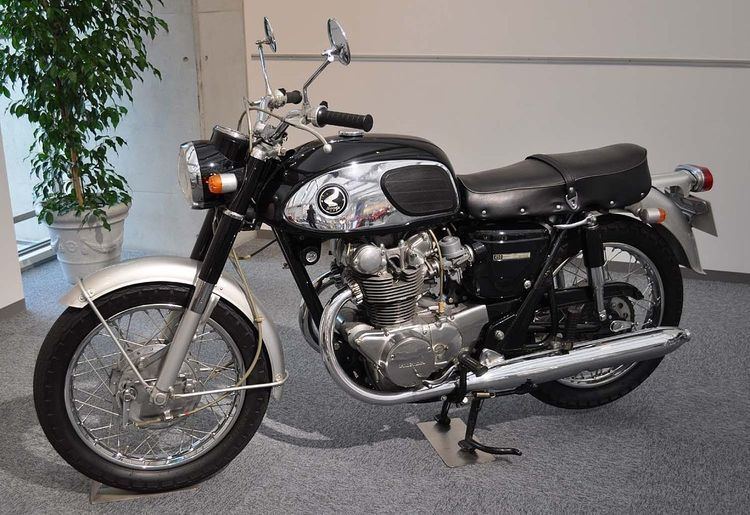Production 1965–1974 | Also called Dream, Hellcat Class Standard | |
 | ||
The Honda CB450 was the first 'big' Honda motorcycle with a 444cc 180° straight twin, dual overhead cam engine producing 43-45 horsepower (more than 100 HP/ litre).
The early models were often known as 'Black Bomber', were notable for their distinctive large chrome-sided fuel tank with the same common 'family' styling used in the S90 and CD175. In Canada the K1 model was marketed as the 'Hellcat'.
Variations
The initial K0 models, known as 'Black Bomber' or 'Dragon' was first shown in UK during the Diamond Jubilee Brighton Speed Trials of September 1965, traditionally held along the seafront. As the bike was newly imported, the engine was not run-in, so the appearance was a semi-competition demonstration sprint run for publicity ridden by (the late) Allan Robinson, MBE, a Honda staff member, recording a standing-start kilometre time of 30.1 seconds and a terminal speed of 100 mph (160 km/h).
The CB450 was then publicly exhibited at the nearby motorcycle show, held for the first time in Brighton at the Metropole Hotel exhibition centre situated on the seafront.
When first evaluating the bike in December 1965, David Dixon, a staff writer for UK magazine Motor Cycle reported that UK sales were planned from February 1966. The price of £360 (GBP) quoted at introduction in the February 1966 Official Honda advertisement was about the same as a traditional UK 650 or 750 sports model.
Honda (UK) planned a further publicity event by entering Mike Hailwood as one of the riders in the Motor Cycle 500 mile production race at Brands Hatch during July 1966. Instead, Hailwood completed demonstration laps on a CB450 before racing began as it was unable to compete in the 500cc category, the FIM deeming it was not classified as a production machine as it had two overhead camshafts.
Although the CB450 never sold up to Honda's expectations, it had excellent engineering for the time, notably including reliable electrical components, an electric starter, and a horizontally split crankcase, all features distinct from the British twins of the era. The most radical feature was the valve springing. Instead of the conventional coil springs, it used 'torsion bars' - rods of steel that twisted to provide the spring effect.
The four-speed K0 model was updated in the K1 model produced from 1968 with a redesigned fuel tank, rubber-gaitered front forks instead of sliding metal shrouds, a five-speed gearbox and twin speedometer and rev-counter instruments mounted above the headlamp.
Later developments progressed through a series of 'K' models with various improvements and styling changes including a single front disc brake, continuing to K7 versions in some markets, until the introduction of the CB500T in 1975.
The basic engine was modified and installed in the Honda N360 car and the exported N600, the precursor to the Honda Civic.
